Wellness company Medifast (NYSE:MED) reported results in line with analysts' expectations in Q1 CY2024, with revenue down 49.9% year on year to $174.7 million. On the other hand, next quarter's revenue guidance of $160 million was less impressive, coming in 10.4% below analysts' estimates. It made a GAAP profit of $0.76 per share, down from its profit of $3.67 per share in the same quarter last year.
Medifast (MED) Q1 CY2024 Highlights:
- Revenue: $174.7 million vs analyst estimates of $173.5 million (small beat)
- EPS: $0.76 vs analyst expectations of $0.80 (5% miss)
- Revenue Guidance for Q2 CY2024 is $160 million at the midpoint, below analyst estimates of $178.5 million (EPS guidance for the same period was well below expectations)
- Gross Margin (GAAP): 72.8%, up from 70.6% in the same quarter last year
- Market Capitalization: $364.9 million
Known for its Optavia program that combines portion-controlled meal replacements with coaching, Medifast (NYSE:MED) has a broad product portfolio of bars, snacks, drinks, and desserts for those looking to lose weight or consume healthier foods.
The company was founded in 1980 by Dr. William Vitale. It initially provided weight-loss solutions directly to doctors, who would then pass them on to patients. While the company initially grew organically through its doctor-driven model, a notable 2010 acquisition of a digital platform has allowed Medifast to establish an online presence.
Today, Medifast is known for its Optavia program. The company also offers bars, snacks such as pretzels and puffs, drinks, and soups that help customers maintain or lose weight. Medifast targets individuals looking to adopt a healthier lifestyle. These are individuals who may have struggled with their weight and found other dieting approaches unsuccessful.
In addition to the products themselves, Medifast offers personal coaching. The coaching aspect is how Medifast facilitates a multi-level marketing approach to selling. Coaches are often customers who sign on to make money by purchasing Medifast products at wholesale prices and selling them at retail to clients.
The multi-level marketing model also lets coaches earn a portion of earnings from other coaches they recruit into the Medifast ecosystem. This model is sometimes a source of skepticism, though. Some argue that these models rely mostly on recruitment to sustain themselves rather than actual demand for products.
Personal Care
While personal care products products may seem more discretionary than food, consumers tend to maintain or even boost their spending on the category during tough times. This phenomenon is known as "the lipstick effect" by economists, which states that consumers still want some semblance of affordable luxuries like beauty and wellness when the economy is sputtering. Consumer tastes are constantly changing, and personal care companies are currently responding to the public’s increased desire for ethically produced goods by featuring natural ingredients in their products.
Multi-level marketing companies offering health and wellness supplements and products include Herbalife (NYSE:HLF), USANA Health Sciences (NYSE:USNA), and Nature’s Sunshine Products (NASDAQ:NATR).Sales Growth
Medifast is a small consumer staples company, which sometimes brings disadvantages compared to larger competitors benefitting from better brand awareness and economies of scale.
As you can see below, the company's revenue has declined over the last three years, dropping 6.5% annually. This is among the worst in the consumer staples industry, where demand is typically stable.
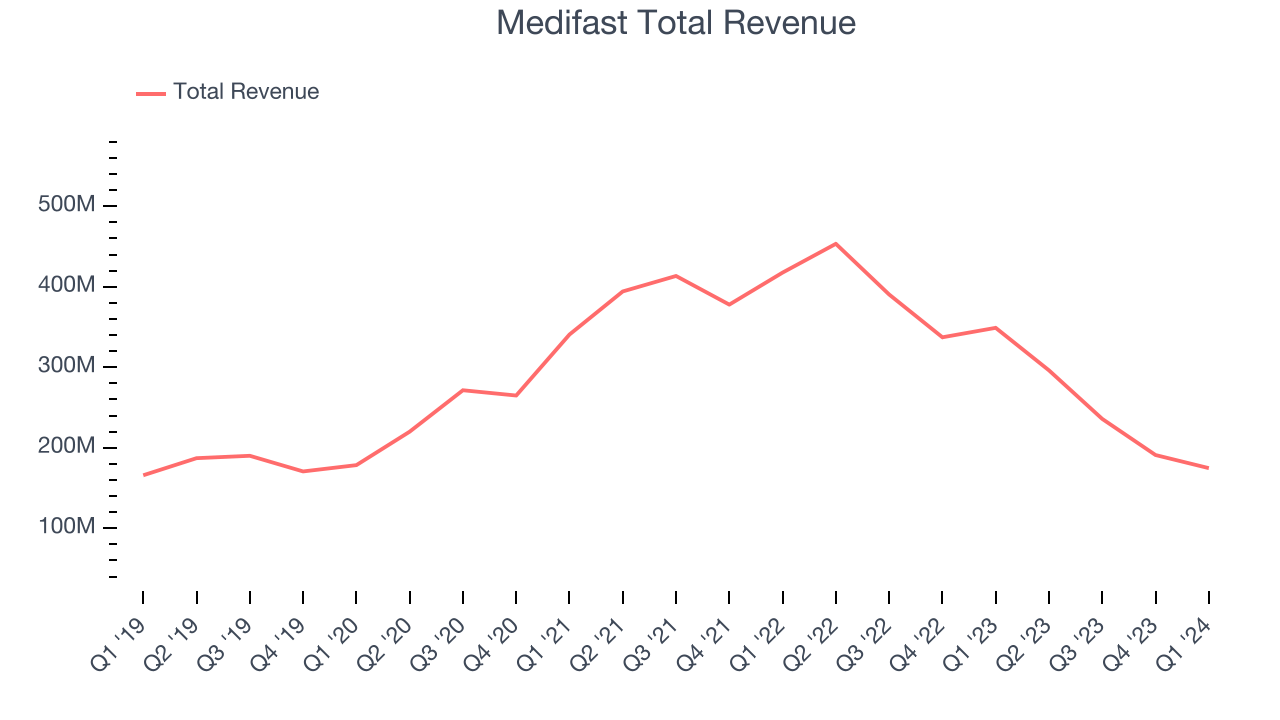
This quarter, Medifast reported a rather uninspiring 49.9% year-on-year revenue decline to $174.7 million in revenue, in line with Wall Street's estimates. The company is guiding for a 46% year-on-year revenue decline next quarter to $160 million, a further deceleration from the 34.7% year-on-year decrease it recorded in the same quarter last year. Looking ahead, Wall Street expects revenue to decline 20.7% over the next 12 months.
Gross Margin & Pricing Power
Medifast's gross profit margin came in at 72.8% this quarter, up 2.2 percentage points year on year. That means for every $1 in revenue, only $0.27 went towards paying for raw materials, production of goods, and distribution expenses.
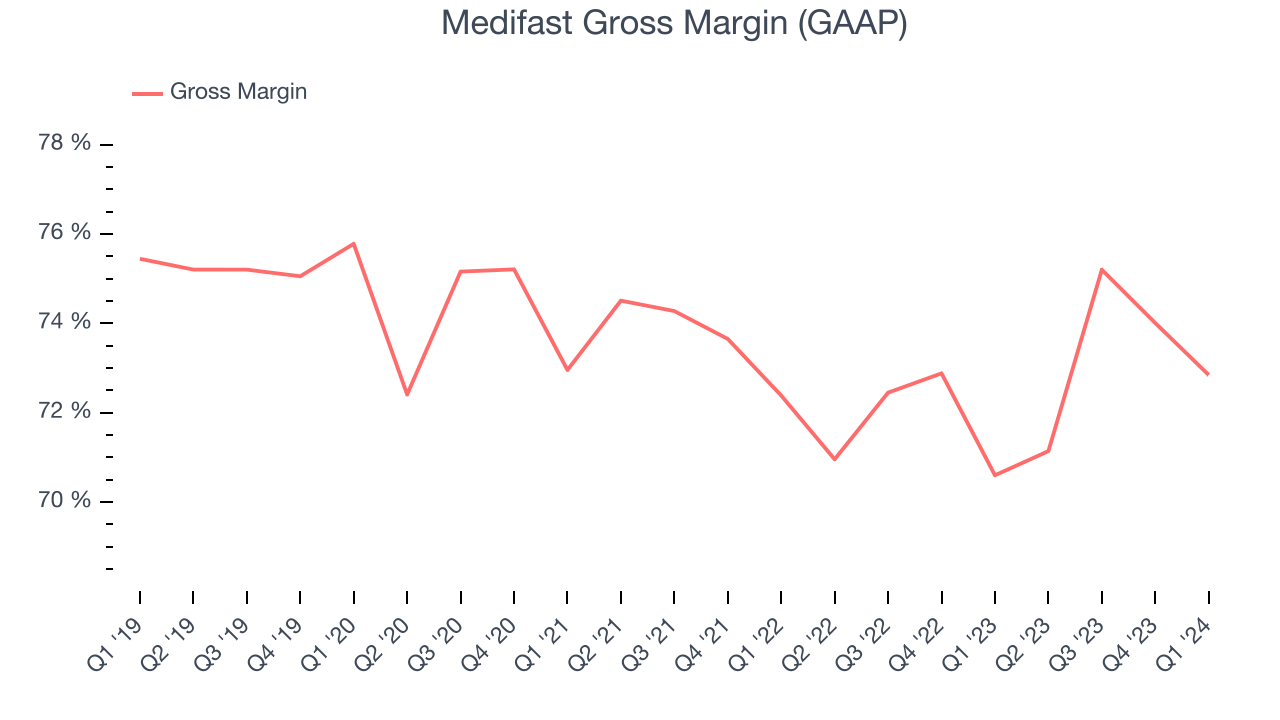
Medifast has best-in-class unit economics for a consumer staples company, enabling it to invest in areas such as marketing and talent to stay one step ahead of the competition. As you can see above, it's averaged an exceptional 72.2% gross margin over the last two years. Its margin has also been trending up over the last 12 months, averaging 2.2% year-on-year increases each quarter. If this trend continues, it could suggest a less competitive environment where the company has better pricing power and more favorable input costs (such as raw materials).
Operating Margin
Operating margin is an important measure of profitability accounting for key expenses such as marketing and advertising, IT systems, wages, and other administrative costs.
In Q1, Medifast generated an operating profit margin of 4.5%, down 10.8 percentage points year on year. Conversely, the company's gross margin actually increased, so we can assume the reduction was driven by operational inefficiencies and a step up in discretionary spending in areas like corporate overhead and advertising.
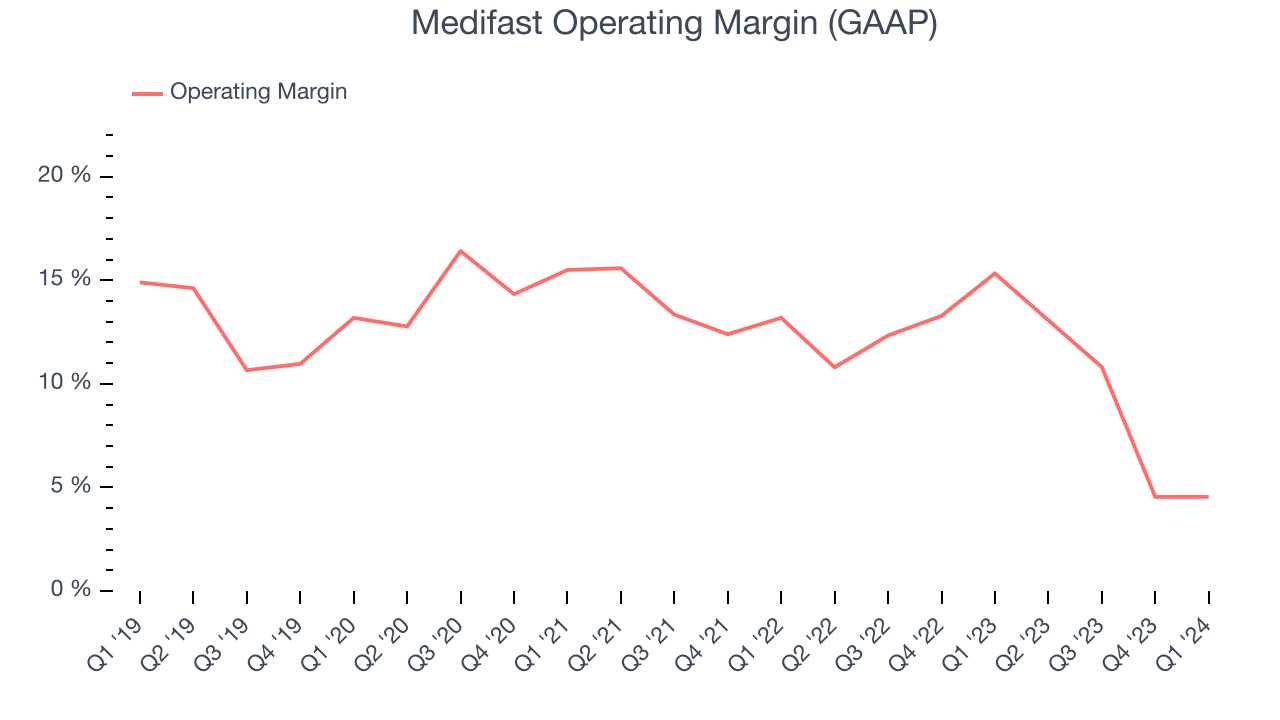 Zooming out, Medifast has done a decent job managing its expenses over the last eight quarters. The company has produced an average operating margin of 11.4%, higher than the broader consumer staples sector. However, Medifast's margin has declined by 3.8 percentage points on average over the last year. Although this isn't the end of the world, investors are likely hoping for better results in the future.
Zooming out, Medifast has done a decent job managing its expenses over the last eight quarters. The company has produced an average operating margin of 11.4%, higher than the broader consumer staples sector. However, Medifast's margin has declined by 3.8 percentage points on average over the last year. Although this isn't the end of the world, investors are likely hoping for better results in the future. EPS
These days, some companies issue new shares like there's no tomorrow. That's why we like to track earnings per share (EPS) because it accounts for shareholder dilution and share buybacks.
In Q1, Medifast reported EPS at $0.76, down from $3.67 in the same quarter a year ago. This print unfortunately missed Wall Street's estimates, but we care more about long-term EPS growth rather than short-term movements.
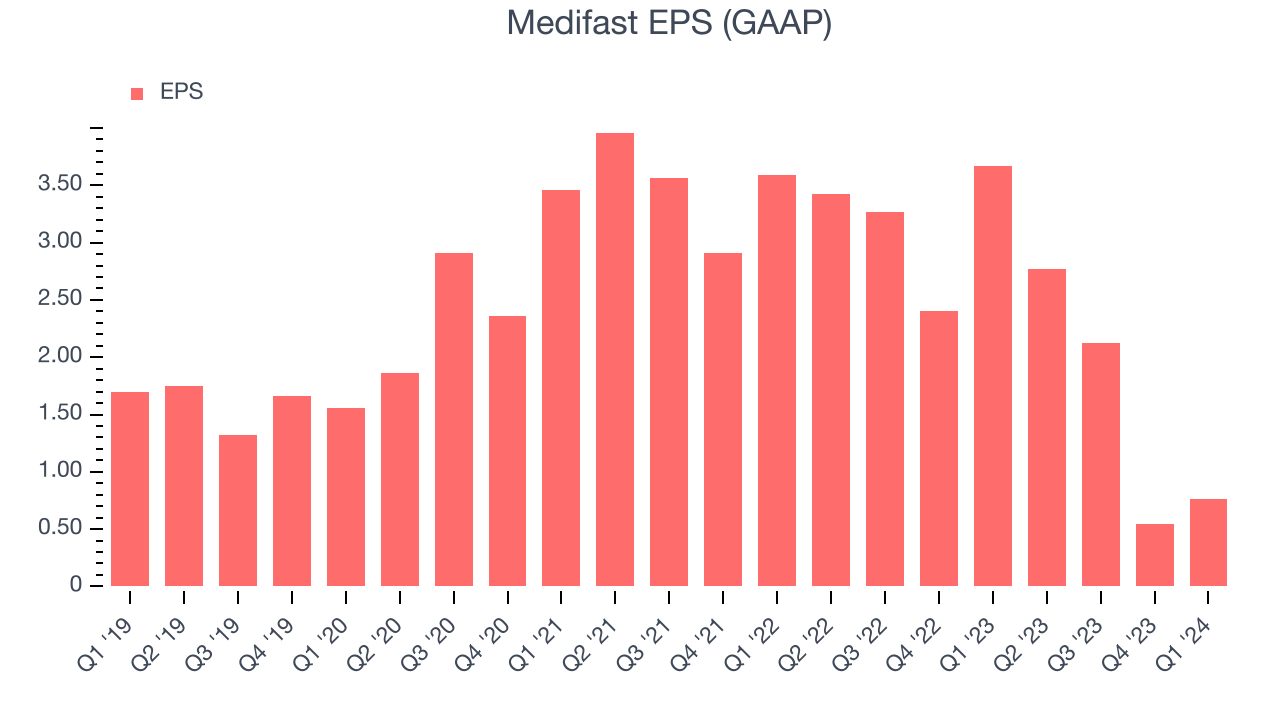
Between FY2021 and FY2024, Medifast's EPS dropped 41.5%, translating into 16.4% annualized declines. We tend to steer our readers away from companies with falling EPS, especially in the consumer staples sector, where shrinking earnings could imply changing secular trends or consumer preferences. If there's no earnings growth, it's difficult to build confidence in a business's underlying fundamentals, leaving a low margin of safety around the company's valuation (making the stock susceptible to large downward swings).
Wall Street expects Medifast to continue performing poorly over the next 12 months, with analysts projecting an average 68.5% year-on-year decline in EPS.
Return on Invested Capital (ROIC)
EPS and free cash flow tell us whether a company was profitable while growing revenue. But was it capital-efficient? Enter ROIC, a metric showing how much operating profit a company generates relative to how much money the business raised (debt and equity).
Although Medifast hasn't been the highest-quality company lately because of its poor top-line performance, it historically did a wonderful job investing in profitable business initiatives. Its five-year average ROIC was 91.8%, splendid for a consumer staples business.
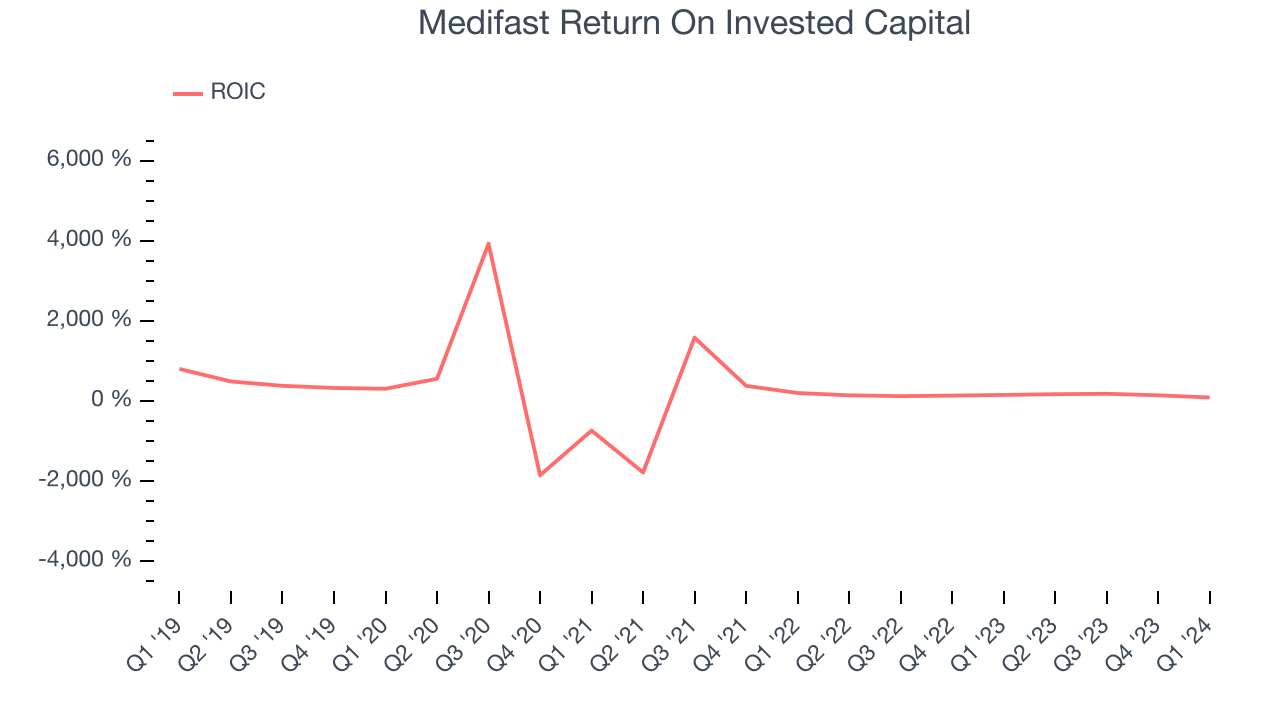
Balance Sheet Risk
Debt is a tool that can boost company returns but presents risks if used irresponsibly.
Medifast is a well-capitalized company with $156.4 million of cash and $20.57 million of debt, meaning it could pay back all its debt tomorrow and still have $135.9 million of cash on its balance sheet. This net cash position gives Medifast the freedom to raise more debt, return capital to shareholders, or invest in growth initiatives.
Key Takeaways from Medifast's Q1 Results
It was encouraging to see Medifast narrowly top analysts' revenue expectations this quarter. On the other hand, its revenue and EPS guidance for next quarter missed analysts' expectations by a large amount and its operating margin missed Wall Street's estimates. Overall, the results were highly disappointing. The company is down 14.3% on the results and currently trades at $30.44 per share.
Is Now The Time?
Medifast may have had a tough quarter, but investors should also consider its valuation and business qualities when assessing the investment opportunity.
We cheer for all companies serving consumers, but in the case of Medifast, we'll be cheering from the sidelines. Its revenue has declined over the last three years, and analysts expect growth to deteriorate from here. And while its impressive gross margins are a wonderful starting point for the overall profitability of the business, the downside is its declining EPS over the last three years makes it hard to trust. On top of that, its projected EPS for the next year is lacking.
Medifast's price-to-earnings ratio based on the next 12 months is 18.2x. While there are some things to like about Medifast and its valuation is reasonable, we think there are better opportunities elsewhere in the market right now.
Wall Street analysts covering the company had a one-year price target of $37.50 per share right before these results (compared to the current share price of $30.44).
To get the best start with StockStory, check out our most recent stock picks, and then sign up to our earnings alerts by adding companies to your watchlist here. We typically have the quarterly earnings results analyzed within seconds of the data being released, and especially for companies reporting pre-market, this often gives investors the chance to react to the results before the market has fully absorbed the information.
